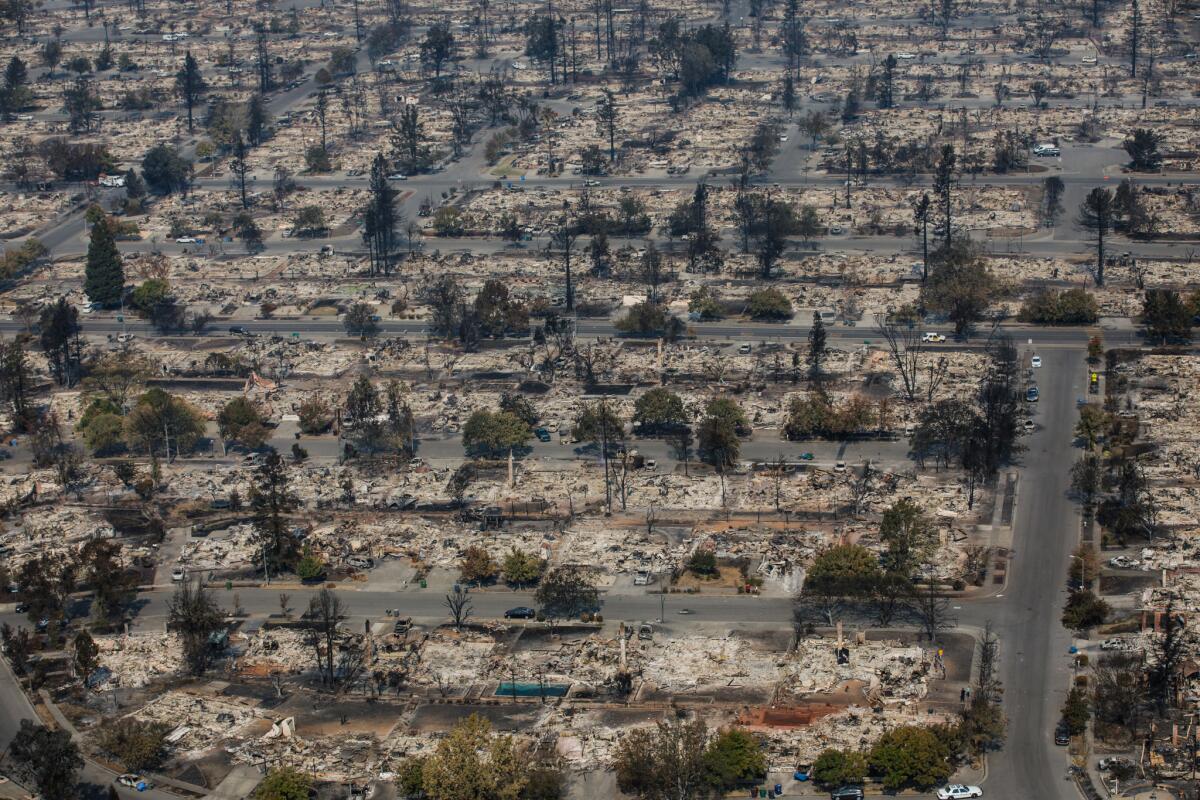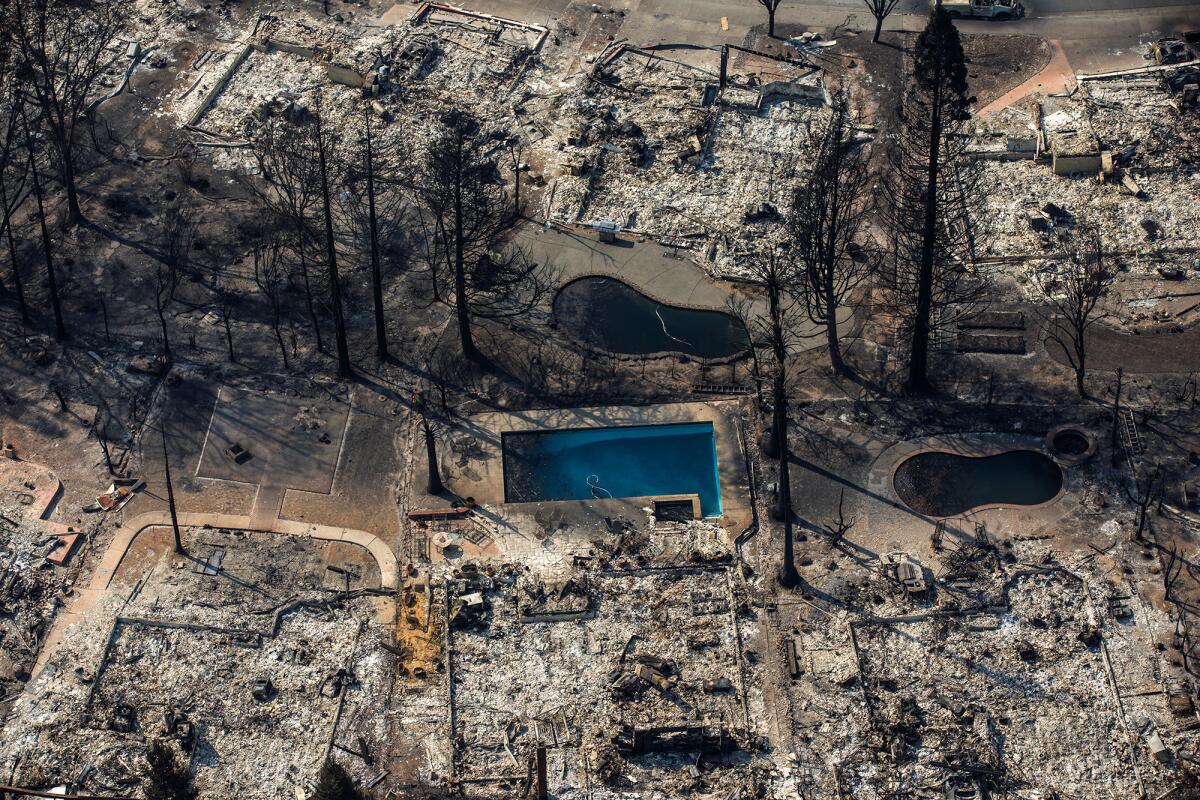After California’s most destructive fire season, a debate over where to rebuild homes

- Share via
After a destructive wildfire swept from Calabasas to Malibu in 1993, the head of the Santa Monica Mountains Conservancy stood on a mountaintop on live TV and made a radical proposal.
He called for a “three-strikes” rule to limit the number of times recovery funds could be spent to help rebuild a home destroyed by wildfire.
Today, Joseph T. Edmiston is still wincing from the blowback. But he hasn’t backed down. Just the opposite.
“I think two strikes is enough and they ought to be bought out,” Edmiston said, after spending three days coordinating the conservancy’s crews on the Skirball, Rye and Creek fires.
He’s not alone. With the frequency and cost of catastrophic wildfires climbing in California, the idea of compensating property owners to not rebuild — or using economic pressure to discourage them from building in the first place — is gaining supporters among those searching for ways to cut wildfire losses. The state has seen its most destructive year of wildfires in its history, with more than 15,000 structures damaged or destroyed and more than 45 people killed. Researchers warn that 2017 is a sign of what’s to come as the effects of a warming climate and unchecked wildlands development converge.
‘Incredibly insensitive and impractical’
“I think what’s next is that every mayor, every town council and city planning board has to take this really seriously,” said Char Miller, professor of environmental analysis at Pomona College. “I would tell a zoning commission in Claremont or wherever, ‘Buy up the land before it gets built. And if a fire comes through, buy up the land so it won’t burn again.’ ”
The question of rebuilding is emotionally and politically fraught. Proximity to nature, beautiful views and remoteness draw people to the wildlands where builders have obtained permits to place houses in areas with high susceptibility to fire. Some of the neighborhoods that burned this year had experienced fire before when there was less development. Houses rebuilt there will soon be at risk again from a fire cycle that experts say is shortening from decades to only years.
But as thousands of property owners deal with the loss of homes and possessions, their ordeal also highlights the moral impediment to asking them to surrender their land.
“I think that is an incredibly insensitive and impractical suggestion,” said Tennis Wick, director of the Permit and Resource Management Department in Sonoma County, where the Tubbs fire this fall took thousands of homes. “We are respecting people’s property rights, and we will be doing everything possible to help people get back into their properties as soon as possible.”
The department has set up special permitting counters to expedite rebuilding.
“Earthquake, fire, flood and landslide — that’s the reality of development in California,” Wick said. “We have to measure risk and mitigate it as best we can.” New homes will be far more resistant to fire than the ones they’ll replace, many dating to the postwar building boom, he said.
“It’s a wicked dilemma, for sure,” said Donald Falk, fire specialist with the University of Arizona’s School of Natural Resources and the Environment. “We at least like to think that we take care of people who have been exposed to disaster. Does that compassion lead us to simply do the same dance over and over again?”
Underlying the dilemma is the difficulty of predicting the likelihood that any particular property will be struck more than once by fire. Across Southern California, wide areas where development meets the mountains are potentially in the path of fire.
“In determining how or why or when homes should be rebuilt after a fire, it helps to have science on where homes should or shouldn’t be placed,” said Alexandra Syphard, senior research scientist at the nonprofit Conservation Biology Institute. “The science isn’t fully there yet.”
The current standard for fire prediction is embodied in maps produced during the 2000s by the California Department of Forestry and Fire Protection.
Largely based on vegetation and topography, the maps cover broad swaths of the state with gradations from moderate to very high fire hazard. In light of experience showing that wind-blown embers can carry fire into suburban areas, Cal Fire plans to revise the maps next year and will likely include even more neighborhoods.
New homes and those being remodeled in very high fire zones must incorporate fire-resistant construction practices such as ember-repelling attic vents and enclosed eaves.
But the areas designated as very high hazard are so extensive — encompassing half a million households in Southern California alone — that they have little value for zoning decisions or pinpointing particular houses or neighborhoods for more aggressive prevention, such as mandatory retrofits.
Syphard and other researchers tackled that problem with a statistical model published by the journal PLOS One in 2012.

Neighborhoods at most risk
Using variables such as the configuration of housing clusters and the number of past fires, the researchers were able to map small fire-prone areas with more accuracy than the state’s fuel-based model.
That promises the potential to support better land-use decisions.
The study concluded that property loss was most likely in neighborhoods with low to intermediate densities and in areas with a history of frequent fire.
But widening the analysis to the whole state remains a challenge, Syphard said, partly because the variables won’t necessarily work the same everywhere. One — the distance from the coast — had the opposite effect in the two areas studied, the Santa Monica Mountains and San Diego County.
But the science is getting better, she said.
“To those naysayers who say, ‘Land-use reform is impossible, just fireproof your home,’ I don’t think it is impossible,” Syphard said. “It’s a question of where to place the incentive. How do you do it fairly? How do you include the science?”
Syphard is now co-leading a two-year project sponsored by the National Science Foundation to examine how fire recovery can be used to increase resiliency in fire-prone areas.
Among the goals, she said, is to construct a nationwide database of post-fire rebuilding: “Are homes rebuilt? What proportion are? Are they sold to new owners, rebuilt by same owners?”
Preemptive purchase of land or development rights in fire-prone areas, whether before or after a fire, is one recommendation of a 2014 white paper published by Headwaters Economics, a Montana nonprofit research group that focuses on land management. Funds could come from the federal Land and Water Conservation Fund or local bond elections, it said.
The key is weighing the cost of protecting homes against the value of the property. Northern California’s Sierra foothills showed promise, Headwaters executive director Ray Rasker said.
“We looked at some fires that cost $700,000 per home,” Rasker said. “Pretty soon you look at the situation where it would have been cheaper to just buy the open space.”
Like most critics of current practices, though, Rasker sees land buyouts as only secondary to a more urgent effort to discourage new development in fire-prone areas.
The Headwaters report found that only about 16% of what is called the wildland-urban interface has been developed in the West, leaving room for huge increases in fire vulnerability if local planning boards continue to approve developments there.
“They’re the ones who decide where the houses are going to go,” Rasker said. “When things go wrong, there is somebody else who has to pay for it, state agencies, federal agencies and the firefighters who put their lives on the line.”
Rasker proposes that federal and state agencies push more of the cost for fire suppression and recovery to local agencies.
“When there is a significant financial consequence to permitting homes in dangerous places, that’s the day we’ll see much better land-use planning,” Rasker said.
Local responsibility
Richard Halsey, director of the California Chaparral Institute, advocates holding local agencies financially responsible for fire losses of developments they approved. They should pay for all costs not covered by insurance and, if the owner rebuilds, all fire safety features, including exterior sprinkler systems.
“This also includes the price of the property at fair market value if the owner wants to leave,” Halsey said.
The nexus between fire hazard and economic pressures has been framed as a socioeconomic principle by Gregory L. Simon, professor in the University of Colorado at Denver’s department of geography and environmental sciences.
“We take profit from the landscape, big construction contracts, cities generating massive amounts of tax revenue,” Simon said. “Simultaneously to generating profits, we’re generating risk and vulnerability.”
He favors methods to reverse the economic pressure, “everything from taking tracts of land at the urban periphery out of development, conservation easements. It might mean promoting higher insurance rates for homes built in high-risk areas such that the demand would go down.”
Mandatory homeowner fire protection fees, such as those instituted in Oakland after the 1991 Tunnel fire, are also helpful, Simon said.

‘We have to say, “Is that fair?”’
Any policies to increase the cost of living in fire-prone areas would, of course, have side effects, heightening the moral dilemma, Falk, the University of Arizona fire specialist, said.
“Let’s realize what that means: People who are more affluent will still build their house where they want to. Middle-class people will be priced out of that market. We have to say, ‘Is that fair?’ ”
From what he sees in the Santa Monica Mountains, conservancy head Edmiston says that’s already happened.
Edmiston said he has tallied 531 proposed new housing units being considered by the cities of Los Angeles and Calabasas in very high fire hazard zones in the Santa Monica Mountains.
“We’re not talking about low income,” Edmiston said. “We’re talking about $1.5-million-plus homes.”
He proposes a linkage between the right to build and the inevitable cost of firefighting and recovery.
As a condition of approval, he said, the developer should establish a mechanism to require purchasers to pay for any increased fire protection that the property will require.
“We’re talking about the climate change paradigm of the Santa Monica Mountains,” Edmiston said. “We’ve got to protect ourselves so that the rest of the city and the rest of the county don’t have to pay for putting these multimillion-dollar houses right next to the risk.”
More to Read
Sign up for Essential California
The most important California stories and recommendations in your inbox every morning.
You may occasionally receive promotional content from the Los Angeles Times.











